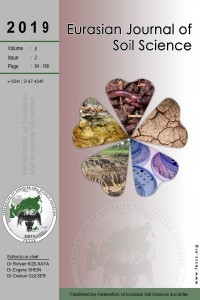
Eurasian Journal of Soil Science
Yazarlar: Zhuyu GU, Yilahong AİKEBAİER, Valeria AREFİEVA, Mikhail MAZİROV
Konular:-
DOI:10.18393/ejss.284265
Anahtar Kelimeler:PH value,Sludge,Microbiological leaching,Substrate concentration,Heavy metals
Özet: Microbial leaching is one of the most effective methods to remove heavy metals from sludge. In the conducted researches, the sludge samples were processed with Thiobacillus ferrooxidans and Thiobacillus thiooxidans obtained via cultivation, extraction and purification processes. Heavy metals such as Pb, Cd, Cu and Ni were leached from sludge by Thiobacillus ferrooxidans and Thiobacillus thiooxidans within different substrate concentration and pH value conditions. It is defined that from the point of view of economy and efficiency the optimal concentration of FeSO4.7H2O and sulfur for bio-leaching process was 0.2 g. The leaching rates of heavy metals such as Pb, Cd, Cu and Ni of the same concentration were 74.72%, 81.54%, 70.46% and 77.35% respectively. However, no significant differences depending on the pH value among the leaching rates were defined, even for the pH value of 1.5. Along with the removal of heavy metals from sludge, the organic matter, N, P, K were also leached to some extent. The losing rate of phosphorus was the highest and reached 38.44%. However, the content of organic matter, N, P, K in the processed sludge were higher in comparison with level I of the National Soil Quality Standards of China. Ecological risk of heavy metals in sludge before and after leaching was assessed by Index of Geo-accumulation (Igeo) and comprehensive potential risk (RI). The results of research defined that the content of heavy metals in sludge meets the level of low ecological risk after leaching and their contents is lower in comparison with the National Agricultural Sludge Standard of China. Sludge leached by biological methods is possible to use for treatment for increasing soil fertility.